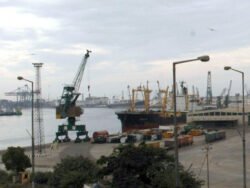BRI’s Future & Expectations from 2 Sessions 2024

28 February 2024
Published in: Business Recorder
The Chinese BRI has become the biggest mega development project of the 21st century which is successfully negating the spillover repercussions of geopolitics, protectionism, unilateralism, war-theatre mentality, isolation, marginalization and gearing the developing countries and Global South towards greater socio-economic integration, connectivity and industrial productivity and cooperation.
Pakistan-China Economic Corridor (CPEC) has become the biggest recipient of the BRI. Since democratic activities of the post-general election 2024 have commenced in Pakistan, there is hope that political stability will be restored, leading toward much-needed economic stability and sustainability in the country. The CPEC will play an important role in the days to come. Hopefully, CPEC Phase-II will empower the commencement of ML-I and other mega projects in the country. Additionally, the upcoming Chinese two sessions have also become beacon of hope for regional as well as world economy, brightening new prospects for greater socio-economic cooperation, connectivity and integration between the two iron brotherly countries i.e. China and Pakistan.
Hopefully, China would promote its national plan to achieve new productive forces for The Two Sessions as the annual meetings of the National People’s Congress (NPC) and the National People’s Political Consultative Conference (NPPCC) will be held on March 4 and 5, respectively. According to some prominent Chinese economists, the policy makers of China may set its GDP target at around 5 percent again for 2024 during the Two Sessions. Last September, Chinese Communist Party (CPC) General Secretary and President Xi Jinping presented the idea of building “new productive forces” for the first time. It may be branding of “new quality productivity” or “high quality development.
It refers to China’s plan to leverage science and technological innovation to generate new industries and speed up the country’s economic development. The Chinese President Xi pinpoints these as deviations from traditional economic growth modes and productivity development paths, features high technology, high efficiency and high quality and comes in line with the new development philosophy which may also be beneficial for the further development and expansion of the CPEC Phase-II in the country.
Xi emphasized that sci-tech innovations should be applied to specific industries and industrial chains in a timely manner. He rightly suggested that integrated efforts should be made to transform and upgrade traditional industries, foster emerging industries, make arrangements for future industries and improve the modern industrial system.
Ironically, the Western nations are using decoupling and delinking policies to suppress the remarkable economic growth of China and halting scientific cooperation with China. This is why China needs to achieve new productive forces to enjoy “first-mover advantage.”
Unfortunately, the US fatally refused to extend a 45-year-old science and technology agreement (STA) with China by another five years. It only extended the STA by six months. The US and China will probably delay the renewal of the STA, which expired on February 27.
The US and its allies in recent years have also encouraged their companies to diversify their new investment to countries other than China. However, China is still the most attractive destination for seeking more and more inflows of FDIs in the world. It is hoped that the Chinese economy will be able to achieve 5 percent growth this year, given that the central government will continue to boost domestic consumption, upgrade its supply chain and nurture new businesses.
Furthermore, its local governments will extend their supportive measures to boost the catering, retail, new energy vehicle, tourism and elderly-care sectors and will play an important role in achieving the desired goals of socio-economic prosperity and sustainability. On the national level, the central government’s plan to develop the advanced manufacturing sectors will be a main theme of the “Two Sessions.”
In 2023, China’s economy grew by 5.2 percent in real terms compared with 2022, while developed economies, by 1.6 percent. For 2024, the IMF forecasts a moderate slowdown in China, to 4.6 percent. High-income nations are expected to grow by 1.5 percent. Critical analysis revealed that China’s GDP growth was higher than that of other emerging markets and developing countries in 2023 and, thus, China’s share of the world economy increased again, to the dismay of those who projected or wished for a reversal of this trend. Short-term projections published by the IMF, for instance, still show China rising relative to the rest of the world.
Evidently, the US is no longer the largest economy. China’s GDP, measured on purchasing power parity (PPP), has been, for a decade, larger than that of the US. On a PPP basis, China currently represents about 19 percent of the world economy, while the US, around 15 percent. Per capita GDP is much higher in the US, but in terms of absolute economic size China has overtaken the US.
China is busy preparing for the annual two sessions of the National People’s Congress (NPC) and the Chinese People’s Political Consultative Conference (CPPCC), some Western media have been enthusiastically hyping that the Chinese economy is collapsing which is untrue.
Admittedly, China-provided public goods including the BRI have been gradually transforming global connectivity, cooperation, and people-to-people communications, and have become an indispensable element in global livelihood and sustainability.
China’s GDP grew by 5.2 percent year on year to 126.06 trillion Yuan ($17.71 trillion) in 2023, according to data released by the National Bureau of Statistics (NBS). It has contributed more than 30 percent to world economic growth for many years in a row, ranking among the top major economies in the world as the largest engine of world economic growth.
Over the past decade, China has implemented numerous opening-up measures, reducing restrictive measures and promoting a more favourable environment for foreign investment. China has remained a strong magnet for global investors, with the country’s landmark Foreign Investment Law offering a powerful guarantee for law-based opening-up. The implementation of the Foreign Investment Law and alignment with international economic and trade rules have further improved the legal framework for foreign investment.
The central government’s timely and effective macro-control measures have helped navigate economic challenges and ensure steady growth. This has provided a favourable environment for both domestic and foreign businesses to thrive, contributing to China’s rapid economic development and improvement in living standards.
According to the IMF’s analysis when China’s growth rate rises by one percentage point, growth in other countries increases by around 0.3 percentage points. It seems that China unswervingly promotes a business environment for investors, and is injecting more impetus into world economic recovery.
In summary, it is suggested that more investment should be made in advanced technologies to update the country’s sectors that produce fundamental parts, material and software, high-end semiconductors and industrial software, especially the industries that are facing suppression of foreign countries.
China should nurture its own technology firms and research institutions that are engaged in work on artificial intelligence, the next iteration of the internet (termed the “metaverse”) and the making of humanoid robots and brain-computer interfaces. Building of Corridors of CHIP and AI among the selected member countries of the BRI would be a long term strategy to move forward and achieve the desired goals of modernization, qualitative industrialization, digitalization, diversification of economy and last but not least trans-regional connectivity. Thus China should use AI, internet of things (IoT) and big data to increase the competitiveness of its advanced manufacturing sectors.





